Burns and scalds
Burns and scalds
Burn injuries
Burns occur when the body is in contact with or too close to dry heat and strong chemicals.
Burns and scalds can have distressing effects, such as scarring, deformity and mental trauma; these effects can all be long-lasting, and sometimes even permanent. Correct, careful and prompt treatment of deep burns is therefore essential.
- Kitchen utensils, such as baking tins, oven shelves and pan handles
- Modern electrical equipment, including kettles, hospitals and irons
- Accidentally fires from open grates, gas and electric fires
- Clothing and other articles accidentally set alight
- Bleach and undiluted disinfectants
- Excessive sun and wind
- Accidents with ropes
Because of their character, burns are most sustained by the exposed parts of the body; particularly the hands, wrists and head. Scalds, on the other hand, occur when the body is in contact with moist heat, such as steam or hot water, fats or oils, and other hot liquids. But there the difference ends for our purposes, because the resulting effect on the skin is much the same. A ‘burn’ means a burn a scald. The damage from burns can range from mere reddening of the affected skin to blister formation and, in more serious cases, to actual destruction of the tissues.
Most burns happen in the home, so that is where they have to be treated; and as most home accidents take place in the kitchen, the kitchen is probably the best room in which to treat casualties. But here again, we stress the need to avoid accidents, for so many of them need never happen. Remember that the groups at the greatest risk are the elderly, the physically handicapped, and children--- especially toddlers. All burns to children and the elderly must be taken seriously.
Some important don'ts
Before describing what burns do to the body and what you can do to help before professional aid is available, here are a few things you must not do when these injuries occur.
- Never put butter, flour or baking soda on a burn
- Never use ointments, lotions or oil as treatment
- Never prick or break any blisters that may form
- Never handle or touch the injury more than absolutely necessary
- Never pull away burnt clothing stuck to the body
Most clothing nowadays is made from synthetic fibers which melt like toffee and stick to the skin. If you attempt to remove it you will tear the skin causing unnecessary pain and inviting infection in. The burnt clothing will have been made sterile and is best left alone.
General treatment
Apart form a few special types of burns; there is a common treatment for all the others. Start off by appreciating that burns, other than very small ones, are dangerous, painful and cause shock. Often they are sustained in an emergency such as a house fire or road accident with a petrol fire. The prime rules of the Help Routine are therefore doubly important and you must remember to keep calm and encourage the casualty, who will be shocked and frightened - be gentle with him - and act quickly yet systematically, always doing first things first.
Once the skin and tissues are burnt, a serious loss of fluid may occur. The affected tissues will hold the heat, and cause further damage and pan. The object of early treatment therefore is to get rid of the heat. First aid treatment must reduce the temperature in the damaged tissue.
Care
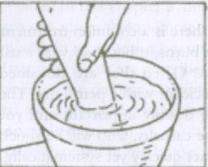
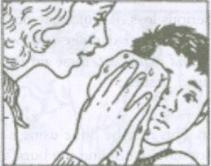
- Immense the injured part in cold water. This may be done using a bucket or washing-up bowl, the kitchen sink, or simply holding the burn under a gently running cold tap.
- The burn should be immersed in cold water for about fifteen minutes or until the pain has stopped. If it is difficult to immerse the injury (on the face, for instance), soak a clean tea-cloth or any other clean soft material in cold water and apply it to the injury as a compress. Remember to change the compress repeatedly (by re-soaking in cold water), but do not rub the surface of the burn. This treatment will take some of the heat out of the tissues and prevent further damage, reddening, blistering and pain
- Remove rings, bracelets, shoes and tight-fitting articles as soon as possible after injury, as swelling may develop making it difficult to remove them later
- Small superficial burns should be carefully patted dry once pain has stopped, and then covered with a dressing. Larger areas or deep burns when removed from the water should be covered lightly with clean, recently-laundered, non-fluffy material. (A clean pillowcase is ideal for limbs)
- Send for a doctor or call for an ambulance
- Any burn larger than a postage stamp (2*21/2 cm) must be seen by a doctor, who should be summoned after you have applied cooling treatment
- When a large area is damaged, requiring hospital care, ice may be packed in a towel and applied to the injury during the journey
- It is essential to cover up burnt tissue to prevent infection, which thrives on burnt skin. This also reduces the anxiety of the casualty, who can no longer see the burn. Tablecloths or sheets (not nylon) are excellent for covering the body. The covering should be held in place lightly
- While waiting for doctor or ambulance, reassure and comfort casualty. Pick-up a child and cuddle: this is most important, but be careful not to do damage in the process.
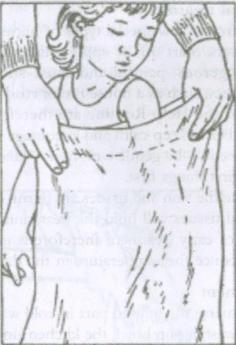
Circumstances requiring special treatment
Clothes on fire
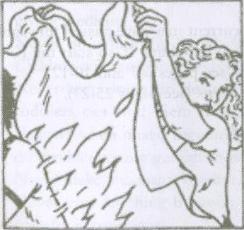
- If clothing is still on fire, extinguish flames by dowsing with water, or cut off the air supply by wrapping casualty in a blanket, coat or other large piece of material --- even a rug. Remember to hold the blanket in front of you to protect you from the flames you are smothering
- Anyone on fire is terrified, and may rush from room to room, spreading the fire, or may run into the fresh air where the fire will burn more readily. Therefore encourage the patient to stay still
- Once the flames are extinguished continue the general treatment for burns already outlined above
Chemical Splashes in the Eye
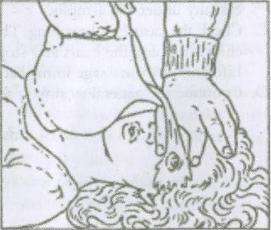
This can cause permanent damage and even loss of vision, and therefore great speed is required in carrying out the treatment. The chemical must be diluted instantly
- Lay the casualty on his back and, holding the eyelids apart with thumb and forefinger; pour cold water continuously over the front of the eye from the nose side (to prevent the chemical affecting the other eye).
- Allow the eyelids to close and open several times to ensure that no chemical is tucked away in the folds of the lids.
- Continue this washing process for at least ten minutes. Do this by the clock, and don’t cut it short.
- After treatment, close the lids, place a pad over the eye, and secure lightly in position.
- Comfort casualty and call for an ambulance or take him to hospital.
Electrical burns
These are often quite small in area, but they may nevertheless be quite deep. They are normally found at the points of contact where the current entered and left the body.
- Switch off the current and remove the plug before treating casualty
- If the casualty is lying in water, keep out of it yourself --- moisture is an excellent conductor of electricity. For the same reason do not hold the casualty under the armpits
- Check the casualty’s breathing. The current may have passed through the chest, stopping the heart and stopping breathing. If so start the Kiss of Life and heart massage immediately
- Continue the general treatment for burns.
Source: Portal Content Team
Last Modified : 2/20/2020
Provides information about Electrical Safety
